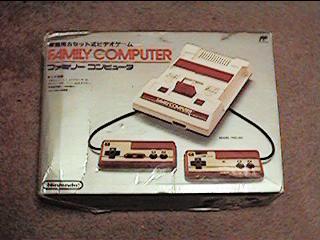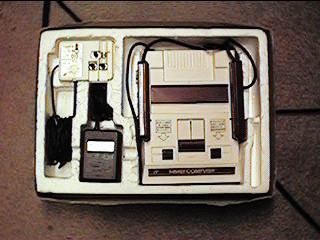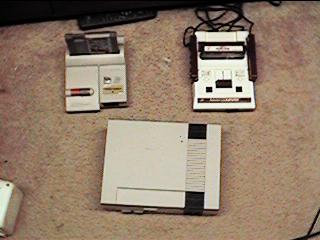The Famicom was, if you haven't figured out yet by perusing this page, the Japanese version of the NES, originally introduced in July of 1983. Nearly 1200 games were released for the Famicom. This was a record, but the Super Nintendo broke it with over 1400 games, and the Playstation has even beat that record. That is a lot of games, by the way. It's a little depressing when you think about it; I'll never be able to play all of these!
Games and systems usually are not shrinkwrapped in Japan - if you find some that are, chances are it was done by a used game shop. A complete box has: a Famicom with 2 controllers (they're wired to the console), an AC adapter, a RF switch, several small pieces of paper with warranty reminders and warnings, and the 33-page comic book Kore ga Family Computer da!!. There were no pack-in games, as is usually the case with systems sold in Japan. Like in the US, Nintendo released a redesigned Famicom in 1993. The Japan version looks the same except for two things: it's got a 60-pin connector, and it's composite input only (as opposed to RF input only on the US version). The original Famicom has RF only, although composite can be hacked in fairly easily. Due to the differences between Japanese and US TV channels, an original, unmodded Famicom cannot be used on US TV sets. Even if you can find a channel that picks it up, the image would be on one channel and the sound would be on another. The redesigned FC can be used on US TVs. You can use the AC adapter that comes with the console (US and Japan electrical outlets aren't exactly the same, but you can get away with using small appliances like a Famicom, as long as you unplug the unit when not in use).
The question is: how hard is this stuff to find in Japan itself? Not especially hard - as always, a lot depends on what game you want, how much time you want to spend searching, and whether you get lucky or not. In Tokyo and other big cities, used games shops have quickly become popular, and most stock at least a few FC carts. The Akihabara section of Tokyo is known around the world as a mecca for electronics lovers, and even if you're a weirdo foreigner with a fixation for old games (ie. me) you'll feel right at home. There are several large game stores with at least a floor devoted to Famicom games, and a number of smaller stores with the proverbial "stack in the corner". Prices vary widely, and as an American you might be surprised at some of the high prices for common (in the US) games such as Metal Gear and Bubble Bobble. Prices for your average cart, with manual and box, ranges from 500 to 1000 yen, with the bottom-of-the-barrel titles (Super Mario Bros. and most baseball games) going for 200 yen on down. Of course, it's easy to tell people to go to Japan to buy FC carts, but hopefully the future will bring a free NES/FC trade between the USA and Japan that the Clinton government could only hope for in other things. =) Back to the odd page. |

 The designers of the
NES made several design changes to the Famicom for US
release. The FC is a top-loading system and has an eject
lever to make game removal easier - sound familiar? In
fact, the design does look a lot like an early 80's Super
Nintendo, doesn't it? There's also the cart size
difference - Famicom carts are 60 pins, while NES carts
are 72. This means that you can't play FC games on a NES
without an
The designers of the
NES made several design changes to the Famicom for US
release. The FC is a top-loading system and has an eject
lever to make game removal easier - sound familiar? In
fact, the design does look a lot like an early 80's Super
Nintendo, doesn't it? There's also the cart size
difference - Famicom carts are 60 pins, while NES carts
are 72. This means that you can't play FC games on a NES
without an  Here's a size
comparison for the 3 different styles of systems. Since
the FC's controllers are hard-wired to the unit, there
are special pockets on the side to put the controllers
when not in use. Joysticks, light guns, and so on are
attached to the 15-pin expansion port on the front edge
of the FC (visible in the picture on the box). There were
a ton of add-ons that used this expansion port. Besides
the well-known Famicom Disk System and 3D Glasses, there
were a multitude of specialized joysticks, modems,
Here's a size
comparison for the 3 different styles of systems. Since
the FC's controllers are hard-wired to the unit, there
are special pockets on the side to put the controllers
when not in use. Joysticks, light guns, and so on are
attached to the 15-pin expansion port on the front edge
of the FC (visible in the picture on the box). There were
a ton of add-ons that used this expansion port. Besides
the well-known Famicom Disk System and 3D Glasses, there
were a multitude of specialized joysticks, modems,